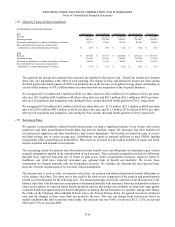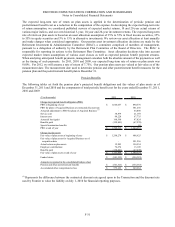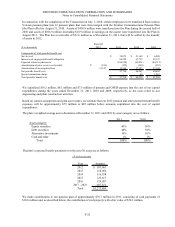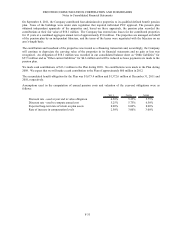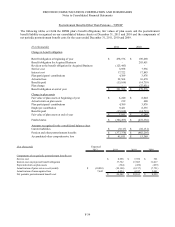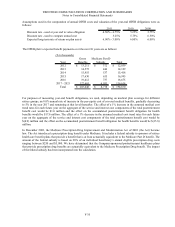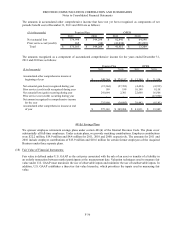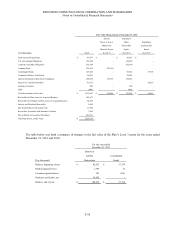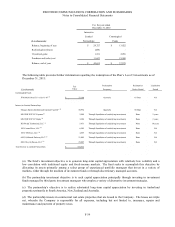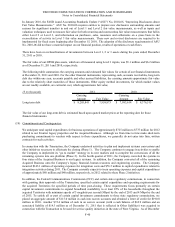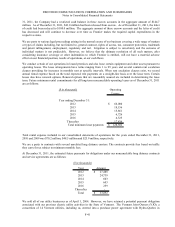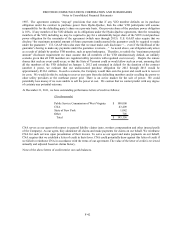Frontier Communications 2011 Annual Report Download - page 103
Download and view the complete annual report
Please find page 103 of the 2011 Frontier Communications annual report below. You can navigate through the pages in the report by either clicking on the pages listed below, or by using the keyword search tool below to find specific information within the annual report.
FRONTIER COMMUNICATIONS CORPORATION AND SUBSIDIARIES
Notes to Consolidated Financial Statements
F-40
In January 2010, the FASB issued Accounting Standards Update (“ASU”) No. 2010-06, “Improving Disclosures about
Fair Value Measurements.” ASU No. 2010-06 requires entities to prepare new disclosures surrounding amounts and
reasons for significant transfers in and out of Level 1 and Level 2 fair value measurements, as well as inputs and
valuation techniques used to measure fair value for both recurring and nonrecurring fair value measurements that fall in
either Level 2 or Level 3, and information on purchases, sales, issuances and settlements on a gross basis in the
reconciliation of activity in Level 3 fair value measurements. These new and revised disclosures are required to be
implemented for fiscal years beginning after December 15, 2010. The adoption of the disclosure requirements of ASU
No. 2010-06 did not have a material impact on our financial position, results of operations or cash flows.
There have been no reclassifications of investments between Level 1, 2 or 3 assets during the years ended December
31, 2011 or 2010.
The fair value of our OPEB plan assets, which are all measured using Level 1 inputs, was $5.1 million and $6.2 million
as of December 31, 2011 and 2010, respectively.
The following table summarizes the carrying amounts and estimated fair values for certain of our financial instruments
at December 31, 2011 and 2010. For the other financial instruments, representing cash, accounts receivables, long-term
debt due within one year, accounts payable and other accrued liabilities, the carrying amounts approximate fair value
due to the relatively short maturities of those instruments. Other equity method investments, for which market values
are not readily available, are carried at cost, which approximates fair value.
($ in thousands)
Carrying Carrying
Amount Fair Value Amount Fair Value
Long-term debt 8,205,841$ 7,958,873$ 7,983,614$ 8,376,515$
2011 2010
The fair value of our long-term debt is estimated based upon quoted market prices at the reporting date for those
financial instruments.
(19) Commitments and Contingencies:
We anticipate total capital expenditures for business operations of approximately $725 million to $775 million for 2012
related to our Frontier legacy properties and the Acquired Business. Although we from time to time make short-term
purchasing commitments to vendors with respect to these expenditures, we generally do not enter into firm, written
contracts for such activities.
In connection with the Transaction, the Company undertook activities to plan and implement systems conversions and
other initiatives necessary to effectuate the closing (Phase 1). The Company continues to engage in activities to enable
the Company to implement its “go to market” strategy in its new markets and to complete the conversions of all the
remaining systems into one platform (Phase 2). In the fourth quarter of 2011, the Company converted the systems in
four states of the Acquired Business to our legacy systems. In addition, the Company converted all of the remaining
Acquired Business onto the Company’s legacy financial, human resources and engineering systems. The Company
incurred $143.1 million of operating expenses for integration costs and $76.5 million in capital expenditures related to
integration activities during 2011. The Company currently expects to incur operating expenses and capital expenditures
of approximately $80 million and $40 million, respectively, in 2012 related to these Phase 2 initiatives.
In addition, the Federal Communications Commission (FCC) and certain state regulatory commissions, in connection
with granting their approvals of the Transaction, specified certain capital expenditure and operating requirements for
the acquired Territories for specified periods of time post-closing. These requirements focus primarily on certain
capital investment commitments to expand broadband availability to at least 85% of the households throughout the
acquired Territories with minimum speeds of 3 megabits per second (Mbps) by the end of 2013 and 4 Mbps by the end
of 2015. To satisfy all or part of certain capital investment commitments to three state regulatory commissions, we
placed an aggregate amount of $115.0 million in cash into escrow accounts and obtained a letter of credit for $190.0
million in 2010. Another $72.4 million of cash in an escrow account (with a cash balance of $62.9 million and an
associated liability of $14.3 million as of December 31, 2011 that is reflected in Other liabilities) was acquired in
connection with the Transaction to be used for service quality initiatives in the state of West Virginia. As of December


